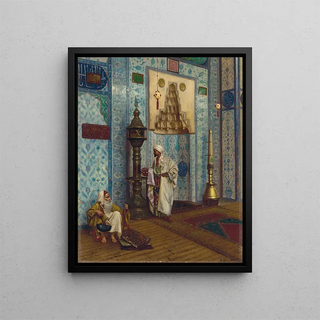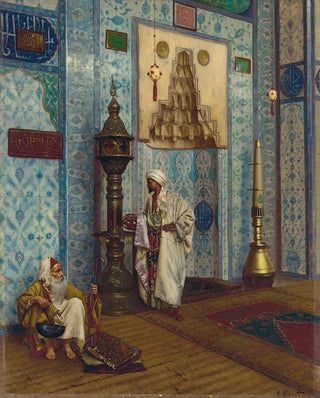Art print | In the mosque - Rudolf Ernst


View from behind

Frame (optional)
In a world where art and culture intersect, the artwork "In the Mosque" by Rudolf Ernst stands out for its captivating atmosphere and narrative depth. This canvas transports the viewer to the heart of a sacred space, evoking a palpable spirituality and rare serenity. The scene, imbued with mystery, invites silent contemplation, where every detail is an invitation to explore the subtleties of inner life. Rudolf Ernst, with exceptional mastery of light and color, manages to create an ambiance that transcends the simple frame of the artwork to immerse the viewer in a sensory and emotional journey.
Style and uniqueness of the artwork
Rudolf Ernst's style is characterized by a harmonious fusion of realism and orientalism, an artistic movement that fascinated many artists in the 19th century. In "In the Mosque," this fusion is expressed through meticulously rendered details, rich ornamental motifs, and play of light that reveal the intrinsic beauty of Islamic architecture. The composition is carefully balanced, with each element of the scene contributing to a powerful visual narration. The characters, although frozen in contemplative postures, seem to experience an intense spiritual moment, offering the viewer a glimpse of a world that is both distant and familiar. The color palette, ranging from warm tones to cooler shades, enhances the mystical atmosphere of the artwork, creating a dialogue between shadow and light that captivates and fascinates.
The artist and his influence
Rudolf Ernst, an Austrian-born painter, established himself in the artistic landscape of his time thanks to his ability to capture the essence of Eastern cultures. His passion for travel and interest in exotic civilizations fueled his work, allowing him to develop a unique style that combines technical precision with artistic sensitivity. Influenced by masters of the past while incorporating contemporary elements, Ernst created a visual language that is his own. His work not only enriched the Orientalist movement but also paved the way for a new appreciation of Islamic art within the Western world. Through his canvases, he reminds us of the importance of

Matte finish

View from behind

Frame (optional)
In a world where art and culture intersect, the artwork "In the Mosque" by Rudolf Ernst stands out for its captivating atmosphere and narrative depth. This canvas transports the viewer to the heart of a sacred space, evoking a palpable spirituality and rare serenity. The scene, imbued with mystery, invites silent contemplation, where every detail is an invitation to explore the subtleties of inner life. Rudolf Ernst, with exceptional mastery of light and color, manages to create an ambiance that transcends the simple frame of the artwork to immerse the viewer in a sensory and emotional journey.
Style and uniqueness of the artwork
Rudolf Ernst's style is characterized by a harmonious fusion of realism and orientalism, an artistic movement that fascinated many artists in the 19th century. In "In the Mosque," this fusion is expressed through meticulously rendered details, rich ornamental motifs, and play of light that reveal the intrinsic beauty of Islamic architecture. The composition is carefully balanced, with each element of the scene contributing to a powerful visual narration. The characters, although frozen in contemplative postures, seem to experience an intense spiritual moment, offering the viewer a glimpse of a world that is both distant and familiar. The color palette, ranging from warm tones to cooler shades, enhances the mystical atmosphere of the artwork, creating a dialogue between shadow and light that captivates and fascinates.
The artist and his influence
Rudolf Ernst, an Austrian-born painter, established himself in the artistic landscape of his time thanks to his ability to capture the essence of Eastern cultures. His passion for travel and interest in exotic civilizations fueled his work, allowing him to develop a unique style that combines technical precision with artistic sensitivity. Influenced by masters of the past while incorporating contemporary elements, Ernst created a visual language that is his own. His work not only enriched the Orientalist movement but also paved the way for a new appreciation of Islamic art within the Western world. Through his canvases, he reminds us of the importance of






